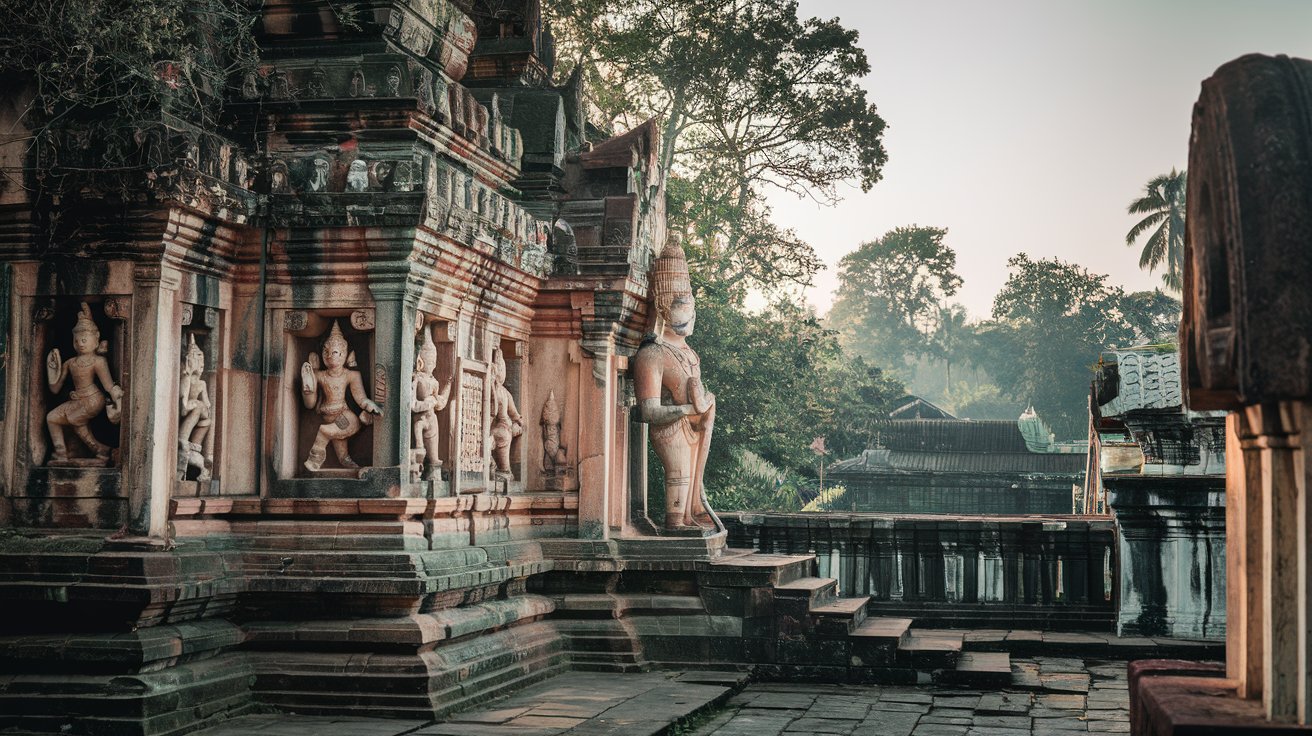
Ever wondered about the spiritual practices that have faded into history? Forgotten religions offer a fascinating glimpse into the diverse beliefs and rituals that once shaped human societies. From the dualistic universe of Catharism to the elaborate ceremonies of Native American tribes, these ancient faiths reveal a rich tapestry of human spirituality. Despite their decline due to persecution, cultural assimilation, or the rise of new religions, many of these beliefs continue to influence modern spirituality. Join us as we explore 30 intriguing facts about these forgotten religions, shedding light on their significance, practices, and the circumstances that led to their decline.
Key Takeaways:
- Forgotten religions offer a fascinating glimpse into ancient cultures, revealing unique spiritual practices and beliefs that have influenced modern spirituality.
- Many forgotten religions, once widespread, declined due to historical events like persecution and cultural assimilation. However, some have experienced modern revivals, showcasing their resilience and ongoing influence.
Forgotten Religions: A Glimpse into the Past
Forgotten religions offer a fascinating look into the diverse spiritual practices of human societies throughout history. These faiths, though no longer widely practiced, provide valuable insights into the cultural, historical, and philosophical contexts of ancient civilizations.
Ancient Persian and Roman Faiths
Some of the most intriguing forgotten religions originated in ancient Persia and the Roman Empire. These faiths often combined elements from various traditions, creating unique spiritual practices.
-
Manichaeism: Founded by Mani in the 3rd century AD, this religion blended Christianity, Zoroastrianism, and Buddhism. Despite its initial popularity in the Roman Empire, it declined due to persecution and the rise of Christianity.
-
Mithraism: A mystery cult in the Roman Empire, Mithraism worshipped a light deity named Mithra. Rituals included baptism and oaths of secrecy. It disappeared after Christian leaders labeled it demonic and persecuted its followers.
Christian Sects and Jewish Groups
Several Christian sects and Jewish groups also faded into obscurity over time. These groups often had unique beliefs that set them apart from mainstream traditions.
-
Catharism: Emerging in the 11th century, Cathars believed in a dualistic universe with an evil god from the Old Testament. They saw women as equals in spiritual leadership. The Albigensian Crusade, called by Pope Innocent III, eradicated Catharism.
-
Sadducees: A Jewish sect during the Second Temple period, the Sadducees did not believe in resurrection or an afterlife. They only accepted the Pentateuch as scripture and disappeared with the destruction of the Jerusalem Temple in 70 AD.
Ancient Pagan Beliefs
Pagan religions, with their rich pantheons and rituals, were once widespread but eventually gave way to newer faiths.
-
Zoroastrianism: One of the oldest major religions, Zoroastrianism has around 100,000 followers today. It shares commonalities with Christianity and has a rich history dating back to ancient Persia.
-
Baltic Paganism: This ancient faith was revived as Romuva, a modern pagan movement in Lithuania. It highlights the resilience of pre-Christian beliefs in the face of cultural assimilation.
-
Tengri: Practiced by Central Asian steppe peoples like the Huns, Mongols, Bulgars, and Magyars, Tengri revered the eternal blue sky and the wolf. Its influence waned, but it still has followers in Mongolia and Russia.
Native American Spiritual Practices
Native American religions are highly localized and diverse, reflecting the rich cultural heritage of indigenous communities.
-
Native American Religions: These faiths included over 300 distinct languages at the time of European contact. Each tribe had unique creation stories and rituals, such as the Iroquois' "Original Instructions" and the Koyukon's decentralized universe.
-
Sun Dance: A significant ritual among many Native American tribes, the Sun Dance ensured the community's well-being and hunters' success. It involved physical endurance and spiritual purification.
-
Vision Quest: A rite of passage for many Native American youth, the Vision Quest involved solitary fasting and prayer to seek spiritual guidance and visions.
-
Ghost Dance: This late 19th-century spiritual movement aimed to restore traditional ways of life and bring back the dead. It was a response to the trauma of European colonization and land loss.
-
Effigy Mound: Built by Native Americans in the eastern United States, effigy mounds honored the dead or marked important events. These mounds provide insights into pre-Columbian cultures.
-
Kiva: Used by Pueblo peoples in the southwestern United States, kivas are ceremonial chambers often built underground. They serve as centers for spiritual and social activities.
Unique Christian Sects
Some Christian sects developed unique practices and beliefs that set them apart from mainstream Christianity.
- Shakers: Known for their strict rules against sex and childbearing, the Shakers were active in the United States from the 18th to the 20th centuries. They were famous for high-quality furniture and communal living.
Greco-Roman and Norse Beliefs
The ancient Mediterranean and Scandinavian regions had rich spiritual traditions that eventually gave way to newer faiths.
-
Greco-Roman Paganism: This ancient faith included various cults like Mithraism and Dionysian worship. It was eventually replaced by Christianity and Islam.
-
Norse Paganism: The pre-Christian faith of Scandinavia, Norse Paganism included the worship of gods like Odin and Thor. It was influenced by Germanic and Celtic traditions and eventually gave way to Christianity.
Ancient Egyptian and Aztec Religions
Ancient Egyptian and Aztec religions were characterized by elaborate rituals and a deep connection to the natural world.
-
Ancient Egyptian Religion: One of the oldest known religions, ancient Egyptian faith included practices like mummification and the worship of deities like Isis and Osiris.
-
Aztec Religion: The pre-Columbian faith of the Aztecs in Mexico was known for human sacrifices and elaborate rituals. It was deeply connected to the natural world and time cycles.
Early and Proto-Religions
Early forms of religious expression often involved animism and the worship of natural elements, laying the groundwork for more complex systems.
-
Proto-Religions: These early forms of religious expression often involved animism and the worship of natural elements like trees and rivers.
-
Early Religions: Ancient Mesopotamian faiths and the Indus Valley Civilization's spirituality show early signs of organized religious practices. These systems often revolved around agricultural cycles and nature deities.
Indigenous Arctic and Southwestern Faiths
Indigenous faiths in the Arctic and southwestern United States had unique rituals and beliefs deeply connected to their environments.
-
Eskimo Religions: The indigenous faiths of the Inuit and Yupik peoples in the Arctic regions revolved around the hunt and respect for nature. Practices included shamanism and the worship of spirits associated with land and sea.
-
Hopi and Navajo Religions: Hopi ceremonies are often communal and scheduled according to natural cycles, while Navajo ceremonies are enacted on behalf of individuals in response to specific needs.
-
Menominee Beliefs: The Menominee people use local geography to explain their origin. Their longhouses are seen as microcosms of the universe, reflecting a deep connection to place and nature.
-
Iroquois Longhouse Elders: These elders frequently speak about the Creator’s “Original Instructions” to human beings, attributing qualities of goodness, wisdom, and perfection to this divinity.
-
Koyukon Universe: The Koyukon universe is decentralized, with Raven being one among many powerful entities. Raven exhibits human weaknesses like lust and pride, teaching more often by counterexample.
Decentralized and Oral Traditions
Many forgotten religions lacked centralized authority structures and written texts, relying on community leaders and oral traditions.
-
Decentralized Religions: Religions like the Koyukon and other indigenous faiths often lack centralized authority structures. Instead, they rely on community leaders and spiritual guides to interpret and practice their traditions.
-
Rituals and Ceremonies: Forgotten religions often had elaborate rituals and ceremonies integral to their spiritual practices. These could include sacrifices, dances, and other forms of communal worship.
-
Sacred Texts: Many forgotten religions lacked written sacred texts. Instead, their traditions were passed down orally through generations, often relying on storytelling and communal memory.
Historical Context and Modern Revival
The decline of forgotten religions was often influenced by historical events, but some have seen modern revivals.
-
Historical Context: The decline of forgotten religions was often influenced by events such as colonization, persecution, and cultural assimilation. These factors led to the erosion of traditional practices and the adoption of new faiths.
-
Resilience and Revival: Despite their decline, many forgotten religions continue to influence modern spirituality. Some have even been revived in contemporary forms, such as Baltic Paganism and Zoroastrianism.
The Enduring Legacy of Forgotten Religions
Forgotten religions offer a fascinating glimpse into the diverse spiritual practices of human societies throughout history. From Manichaeism and Mithraism to Catharism and Zoroastrianism, these faiths shaped cultures and influenced modern spirituality. Despite their decline due to persecution, colonization, and cultural assimilation, many of these religions continue to impact contemporary beliefs. Some, like Baltic Paganism and Zoroastrianism, have even seen revivals. The rituals, ceremonies, and sacred texts of these ancient faiths highlight the resilience of human spirituality. Understanding these forgotten religions enriches our knowledge of history and deepens our appreciation for the diversity and complexity of spiritual expression. Their enduring legacy reminds us of the importance of preserving cultural heritage and the power of human belief systems.
Frequently Asked Questions
Was this page helpful?
Our commitment to delivering trustworthy and engaging content is at the heart of what we do. Each fact on our site is contributed by real users like you, bringing a wealth of diverse insights and information. To ensure the highest standards of accuracy and reliability, our dedicated editors meticulously review each submission. This process guarantees that the facts we share are not only fascinating but also credible. Trust in our commitment to quality and authenticity as you explore and learn with us.


